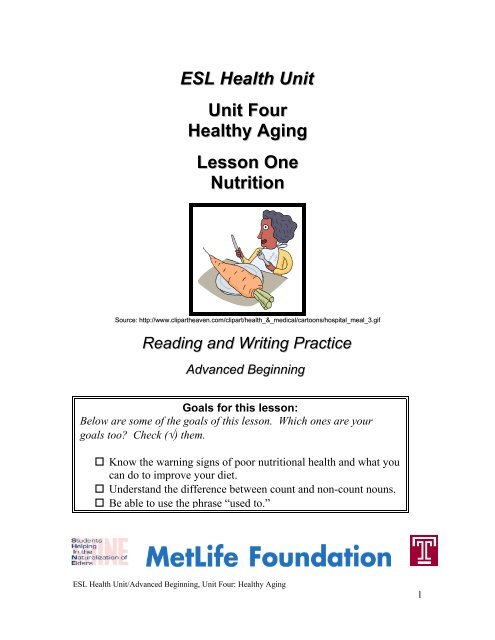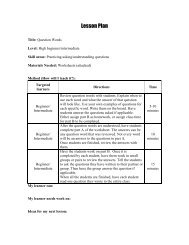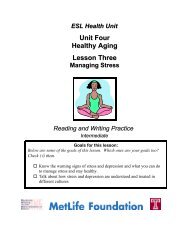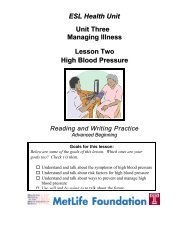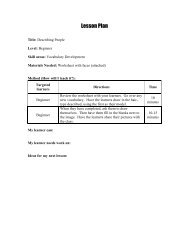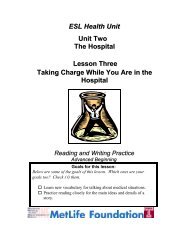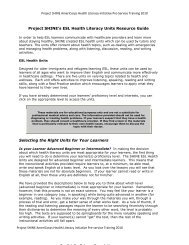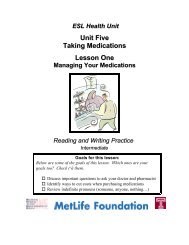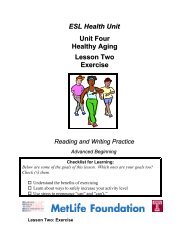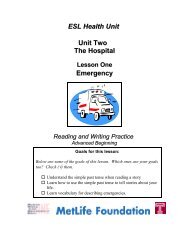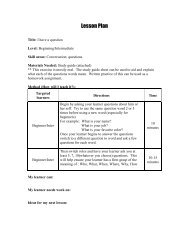ESL Health Unit - Project SHINE
ESL Health Unit - Project SHINE
ESL Health Unit - Project SHINE
- No tags were found...
You also want an ePaper? Increase the reach of your titles
YUMPU automatically turns print PDFs into web optimized ePapers that Google loves.
<strong>ESL</strong> <strong>Health</strong> <strong>Unit</strong><strong>Unit</strong> Four<strong>Health</strong>y AgingLesson OneNutritionSource: http://www.clipartheaven.com/clipart/health_&_medical/cartoons/hospital_meal_3.gifReading and Writing PracticeAdvanced BeginningGoals for this lesson:Below are some of the goals of this lesson. Which ones are yourgoals too? Check (√) them. Know the warning signs of poor nutritional health and what youcan do to improve your diet. Understand the difference between count and non-count nouns. Be able to use the phrase “used to.”<strong>ESL</strong> <strong>Health</strong> <strong>Unit</strong>/Advanced Beginning, <strong>Unit</strong> Four: <strong>Health</strong>y Aging1
Lesson One: NutritionReading and Writing PracticeBefore You Read!In this lesson, you will read about Eleanor’s problem with her diet. Eleanorwent to the doctor. The doctor gave her this food pyramid and asked her tofollow it. Before you read Eleanor’s story, study the pyramid. Answer thequestions that follow with your classmates and teacher.<strong>ESL</strong> <strong>Health</strong> <strong>Unit</strong>/Advanced Beginning, <strong>Unit</strong> Four: <strong>Health</strong>y Aging2
<strong>ESL</strong> <strong>Health</strong> <strong>Unit</strong>/Advanced Beginning, <strong>Unit</strong> Four: <strong>Health</strong>y Aging3
Activity One:1. Look at each section of the pyramid. Make a list of some of thefoods that you see in each food group.Food group:Water/liquidsGrains andCerealsBright coloredvegetablesDeep colored fruitDairy productsDry beans, nuts,Examples of foods:broccoliapplesmilkfish, poultry, meatand eggsFats, salt, sugarsVitamincalciumsupplements2. Which food groups should you eat the most of?3. Which food groups should you eat the least of?<strong>ESL</strong> <strong>Health</strong> <strong>Unit</strong>/Advanced Beginning, <strong>Unit</strong> Four: <strong>Health</strong>y Aging4
4. What are your favorite foods? Which food groups do your favoritefoods belong to?Grammar Tip: Count vs. non-count nounsWhen we are talking about food, it is important to know the differencebetween count and non-count nouns. In this grammar focus, you will learn to<strong>ESL</strong> <strong>Health</strong> <strong>Unit</strong>/Advanced Beginning, <strong>Unit</strong> Four: <strong>Health</strong>y Aging5
Use the noun plural ending -s correctly Use words that express quantities, such as some, many, a little…Count vs. Non-countThere are two kinds of nouns: those that can be counted and those thatcannot be counted.Count nouns refer to things that can be divided up into smaller parts. Wecan see or hear these things and count them. Count nouns can be made pluralby adding a final -s to the nouns. Here are some nouns that you can count:Count nounsapplebottlecartonhamburgerPlural count nouns(two) apples(three) bottlescartonshamburgersNon-count nouns refer to things that cannot be counted because they arewhole things which cannot be divided into parts.Illustration: Think of the batter you use to bake a cake. Before you put thebatter into the oven, you cannot divide it into its parts because it is a liquidmix. Think of the liquid mix as a non-count noun.<strong>ESL</strong> <strong>Health</strong> <strong>Unit</strong>/Advanced Beginning, <strong>Unit</strong> Four: <strong>Health</strong>y Aging6
Picture taken from: http://www.asahi-net.or.jp/~bd9y-ktu/test/ishi/people_f/ill_f/nkitchen_f/batter.GIFAfter you bake the cake, it becomes solid and you can cut it into pieces.Now you can think of the pieces of cake as the count nouns. We can countthe cake and its pieces.Picture taken from: http://www.cut-the-knot.org/do_you_know/cake.gifNon-count nouns cannot be not made plural. For example: milk cannotbecome “milks”. If we divide non-count nouns into parts, we need to usea quantifier. Here are some examples of non-count nouns and quantifiers:<strong>ESL</strong> <strong>Health</strong> <strong>Unit</strong>/Advanced Beginning, <strong>Unit</strong> Four: <strong>Health</strong>y Aging7
Non count nounsmeatbreadwatermilkNon-count nouns withquantifierssome meata package of breada glass of watertwo cartons of milkQuantifiersQuantifiers are words that give us more information about nouns. They tellus how many or how much. To choose the correct quantifier you need toknow whether the word is a count or a non-count noun. Look at theexamples for the count noun eggs and the non-count noun water.<strong>ESL</strong> <strong>Health</strong> <strong>Unit</strong>/Advanced Beginning, <strong>Unit</strong> Four: <strong>Health</strong>y Aging8
Use these quantifiers with countnouns:several eggsfew eggsnone of the eggsUse these quantifiers with non-countnouns:a little watervery much waterno waterUse these quantifiers with both count and non-count nouns:all of the eggs/watersome eggs/watera lot of eggs/waterNote: with foods, some non-count words such as water, coffee or meat, wecan add a counting phrase to talk about quantities, like:A cup/two cups of milkA glass/two glasses/a couple of glasses of waterA package/two packages of meatPractice OneLook at the list of nouns and identify if they are count or non-count.Pluralize the count nouns.Noun Count or non-count? Plural form1. apple2. jar<strong>ESL</strong> <strong>Health</strong> <strong>Unit</strong>/Advanced Beginning, <strong>Unit</strong> Four: <strong>Health</strong>y Aging9
3. meat4. hamburger5. milk6. coffee7. egg8. bottle9. broccoliPractice TwoLook at the nouns in the following sentences and decide if they are corrector not. Check (√) the appropriate column1. The mother gave some milks to herchildren.2. Today at lunch I ate a couple of apple.3. I have a lot of jars in my kitchen.4. Every afternoon we go to the café to havea cup of coffee.5. My friend likes to eat eggs for breakfast.6. We used three broccolis in the recipe.7. McDonald’s sells hamburgers all over theCorrectIncorrectworld.<strong>ESL</strong> <strong>Health</strong> <strong>Unit</strong>/Advanced Beginning, <strong>Unit</strong> Four: <strong>Health</strong>y Aging10
<strong>ESL</strong> <strong>Health</strong> <strong>Unit</strong>/Advanced Beginning, <strong>Unit</strong> Four: <strong>Health</strong>y Aging11
Practice ThreeHow much food should we eat according to the food pyramid? Choosewhich quantifier is most appropriate in the following sentences.1. Drinking __________________ coffee can be unhealthy.a. several b. two cups of2. To stay healthy, we should try to eat ___________________ fruitevery day.a. some b. several3. We should eat __________________ nuts.a. a lot of b. few4. Adding ___________________ broccoli to your diet is healthy.a. some b. few5. The food pyramid recommends that we eat __________________ fat.a. a lot of b. a little
6. Eating ___________________ bright colored vegetables is healthy.a. very much b. a lot of7. My doctor recommends that I eat __________________ whole grains.a. six servings of b. a little8. Drinking ___________________ liquids prevents dehydration.a. very much b. a lot of<strong>ESL</strong> <strong>Health</strong> <strong>Unit</strong>/Advanced Beginning, <strong>Unit</strong> Four: <strong>Health</strong>y Aging 17
Activity Two:What do you usually eat each day? In the space below, describe your dietand share it with your partner. As you list the foods you eat be sure to useplural forms and quantifiers.1. What do you eat for breakfast?2. What do you eat for lunch?3. What do you eat for dinner?4. Do you have snacks during the day? What are they?5. How much water/liquid do you drink each day?<strong>ESL</strong> <strong>Health</strong> <strong>Unit</strong>/Advanced Beginning, <strong>Unit</strong> Four: <strong>Health</strong>y Aging 18
Reading OneThis story was generated by the course developer for instructional purposes.Next read Eleanor’s story and answer the questions that follow with yourclassmates and teacher.My name is Eleanor and I am 80 years old. I used to cook for myself. Iused to walk to the store everyday with my friend Celia to buy the things Ineeded. But last year my eyesight got badand I couldn’t walk to the market anymore.Since then my diet has not been very good.I often skip meals. When I do eat, I eat a lotof junk food, especially sweets.New wordsSkip meals: not eat mealsJunk-food: food with littlenutritional valueDehydrated: the effect ofnot drinking enough waterThe last time I went to the doctor, she said Igained 15 pounds and I was dehydrated. I have diabetes and must keep myweight low. She told me I needed to change my diet. First, I have to drinkmore every day. I have to eat more fruits, vegetables and whole grains. Ineed to eat less meat and less fat. I also need to take a vitamin supplement.<strong>ESL</strong> <strong>Health</strong> <strong>Unit</strong>/Advanced Beginning, <strong>Unit</strong> Four: <strong>Health</strong>y Aging19
I am worried about my diet now but I don’t know what to do. I can’t walk tothe market anymore and I can’t see well enough to cook for myself.1. Why did Eleanor change her eating habits?2. Why is Eleanor’s doctor worried about her weight gain?3. Eleanor needs to change her diet. What foods should she eat more?4. What foods should Eleanor eat less?5. Do you think Eleanor will follow her doctor’s advice? Why or whynot?<strong>ESL</strong> <strong>Health</strong> <strong>Unit</strong>/Advanced Beginning, <strong>Unit</strong> Four: <strong>Health</strong>y Aging 20
Nutrition Risk TestCould your diet put you at risk for serious health problems? Answer thefollowing questions with your classmates and teacher and then discuss yournutritional health score.Read the statements below and check "Yes" for those that apply to you.1. I have a medical condition that made me change the food I eat. □ Yes2. I eat fewer than 2 meals per day. □ Yes3. I eat few fruits, vegetables, or milk products. □ Yes4. I have tooth or mouth problems that make it hard for me to eat. □ Yes5. I don't always have enough money to buy the food I need. □ Yes6. I am not always physically able to shop, cook and/or feed□ Yesmyself.Now total your nutritional score.<strong>ESL</strong> <strong>Health</strong> <strong>Unit</strong>/Advanced Beginning, <strong>Unit</strong> Four: <strong>Health</strong>y Aging 21
0.2 You have no need to change your diet. Take this quiz again in6 months.3.5 See what you can do to improve your diet and lifestyle. Bringthis quiz with you the next time you visit a medical professionalor social services agency. Ask for help to improve yournutritional health.Discuss your score with your classmates. Do you or any of your classmateshave problems with your diet? Work together to make a list of suggestionsfor what everyone can do to improve their nutrition. If you can’t think ofany solutions to this problem, read through the <strong>Health</strong> Watch box below forideas.<strong>ESL</strong> <strong>Health</strong> <strong>Unit</strong>/Advanced Beginning, <strong>Unit</strong> Four: <strong>Health</strong>y Aging 22
<strong>Health</strong> Watch: What you can do to improve your nutritional healthIt is important to pay attention to the warning signs of poor nutritionalhealth. If you have any of these problems, read what you can do to improveyour health.Problem: Can't chew (biting your food with your teeth)Do you have trouble chewing? If so, you may have trouble eating foods likemeat and fresh fruits and vegetables.What to do: Try other foods.<strong>ESL</strong> <strong>Health</strong> <strong>Unit</strong>/Advanced Beginning, <strong>Unit</strong> Four: <strong>Health</strong>y Aging 23
Problem: Can't shopYou may have problems shopping for food. Maybe you can't drive anymore.You may have trouble walking or standing for a long time.What to do:• Ask the local food store to bring groceries to your home.• Ask a family member or neighbor to shop for you.• Sign up for help with a local volunteer center, church or synagogue.Instead of:Try:fresh fruitfruit juices andsoft cannedfruits, likeapplesauceraw vegetablesvegetablejuices and<strong>ESL</strong> <strong>Health</strong> <strong>Unit</strong>/Advanced Beginning, <strong>Unit</strong> Four: <strong>Health</strong>y Aging 24cooked
meatground meat,eggs, and foodsmade withmilk, likecheese, yogurtand creamsoupssliced bread<strong>ESL</strong> <strong>Health</strong> <strong>Unit</strong><strong>Unit</strong> Four<strong>Health</strong>y AgingLesson OneNutritioncooked cereals,rice, breadpuddingListening and Speaking PracticeAdvanced BeginningGoals for this lesson:Below are some of the goals of this lesson. Which ones are yourgoals too? Check (√) them. Know the warning signs of poor nutritional health and what youcan do to improve your diet. Understand the difference between count and non-count nouns. Be able to use the phrase “used to.”<strong>ESL</strong> <strong>Health</strong> <strong>Unit</strong>/Advanced Beginning, <strong>Unit</strong> Four: <strong>Health</strong>y Aging 25
Lesson One: NutritionListening and Speaking Practice!Before You Listen!VocabularyStudy these new vocabulary words before you listen. Read the sentences andguess the meaning of the bold words from context. Discuss the words withyour teacher.1. My father is the chef in the family. He cooks delicious foods.2. The four main ingredients in bread are flour, salt, yeast and water.3. My mother always uses recipes when she cooks. She likes to followthe instructions very carefully.4. My doctor advises me to avoid salt and fat in my diet. I should stayaway from these ingredients.5. Antonio cooks delicious fried chicken. He cooks the chicken in oil.<strong>ESL</strong> <strong>Health</strong> <strong>Unit</strong>/Advanced Beginning, <strong>Unit</strong> Four: <strong>Health</strong>y Aging 26
6. Salt and pepper are typical seasonings. They add flavor to food. Theymake food taste better.Activity One:Answer the following questions and then review them together as a class.1. Do you like to cook? If so, do you cook with recipes?2. What kinds of ingredients are most common in a healthy diet?<strong>ESL</strong> <strong>Health</strong> <strong>Unit</strong>/Advanced Beginning, <strong>Unit</strong> Four: <strong>Health</strong>y Aging 27
Listening One: <strong>Health</strong>y recipes**Note to teacher: Do not pass out the written text below until students areready for the “Talk About It!” activity. Record it onto a cassette andhave students listen to the recording (if you have time, it may behelpful to ask a friend or family member to record this message sothat your learner(s) can practice listening to an unfamiliar voice).Play once or twice before they begin to listen for specific information.Listen to the conversation from a call-in radio talk show. A chef is talkingabout how to cook healthy foods. Listen to the conversation and thenanswer the questions that follow with your classmates and teacher.Chef Wong:Welcome to the show. Today, we are talking about howto cook healthier foods. We all know that to stay healthy,we need to eat more fruits, vegetables and whole grains.We also need to limit the fat, salt and sugar in our diet.How can we control our diet? Cook at home, usingsimple recipes and fresh ingredients. Today we’ll discussmaking your favorite recipes healthier. Let’s talk aboutcooking! …. Ok, looks like we have a call. Hello? Areyou there, caller?<strong>ESL</strong> <strong>Health</strong> <strong>Unit</strong>/Advanced Beginning, <strong>Unit</strong> Four: <strong>Health</strong>y Aging 28
Maria:Hello? Yes?Chef Wong:Hi. Welcome to the show. Please introduce yourself.Maria:My name is Maria and I’m calling from Philadelphia. I recentlylearned that I have high blood pressure, and my doctortold me I need to lose weight. I love cooking and eating,so I am worried about using my old recipes. Maybe theyare not healthy for me. Can you help me?Chef Wong:Sure. Don’t worry! Learning to cook healthy food issimple. Do you have a favorite recipe you’d like to talkabout?Maria:Yes. I really love to cook fried chicken with rice. My mothertaught me how to make it.<strong>ESL</strong> <strong>Health</strong> <strong>Unit</strong>/Advanced Beginning, <strong>Unit</strong> Four: <strong>Health</strong>y Aging 29
Chef Wong:Well, your basic ingredients, chicken and rice, soundhealthy. Tell me more about your recipe. How do youcook this dish?Maria:Well, first I season my chicken with lots of salt and spices, youknow, to give it flavor. Then I heat one cup of olive oil ina frying pan and I add the chicken.Chef Wong:Ok, let’s start with your seasoning. Try to reduce theamount of salt. Use healthier seasoning like pepperinstead. Also, one cup of oil is too much! You can frychicken with only 2 tablespoons of oil.Maria:If I make these changes will my dish still have the same flavor?Chef Wong:No. For more flavor, try adding some vegetables to yourrecipe, like broccoli or tomatoes. Add only healthyingredients. Remember the food pyramid! We should allavoid eating too much salt and fat.<strong>ESL</strong> <strong>Health</strong> <strong>Unit</strong>/Advanced Beginning, <strong>Unit</strong> Four: <strong>Health</strong>y Aging 30
Maria:Ok, that sounds like a good idea. I will try it this weekend.Thank you, Chef Wong.Chef Wong:You’re welcome, Maria. Good luck!Activity TwoChoose whether the following statements are true or false based on thelistening:1. To stay healthy we should eat more fruits and vegetables. T F2. Maria has diabetes and needs to lose weight. T F3. Maria loves cooking and eating. T F4. Chef Wong advises Maria to use less oil. T F5. If she follows Chef Wong’s advice, the flavor of Maria’s dishwill remain the same.T F6. Maria will try the new recipe. T F<strong>ESL</strong> <strong>Health</strong> <strong>Unit</strong>/Advanced Beginning, <strong>Unit</strong> Four: <strong>Health</strong>y Aging 31
Activity Three:Listen again and try to fill in the missing nouns from the following segmentsfrom Chef Wong. When you finish compare answers with your neighbor.Can you identify the count and non-count nouns?Segment OneWelcome to the show. Today, we are talking about how to cook healthier______________. We all know that to stay healthy, we need to eat more______________, vegetables and whole grains. We also need to limit the______________, salt and sugar in our diet. How can we control ourdiet? Cook at home, using simple recipes and fresh ______________.Today we’ll discuss making your favorite ______________ healthier.Segment Two<strong>ESL</strong> <strong>Health</strong> <strong>Unit</strong>/Advanced Beginning, <strong>Unit</strong> Four: <strong>Health</strong>y Aging 32
No. For more flavor, try adding some ______________ to your recipe,like broccoli or ______________. Add only healthy ingredients.Remember the food pyramid! We should all avoid eating too much______________ and fat.Activity FourPractice the dialogue with a partner. Take turns being Maria and ChefWong.<strong>ESL</strong> <strong>Health</strong> <strong>Unit</strong>/Advanced Beginning, <strong>Unit</strong> Four: <strong>Health</strong>y Aging 33
Talk About It!Grammar Tip: Used ToWe use “used to” to talk about things we did in the past but do not doanymore. For example: I used to do my own grocery shopping, but now my eyes are bad and Ican’t see well enough. Juan used to think he could not cook, but now he cooks for himselfevery day and he enjoys it!<strong>ESL</strong> <strong>Health</strong> <strong>Unit</strong>/Advanced Beginning, <strong>Unit</strong> Four: <strong>Health</strong>y Aging 34
Structure:used to + main verbPronunciation note: RhythmWhen you pronounce the verb phrase with used to, the word ‘to’ is reduced.In spoken English, it sounds like “ta”. The main verb gets stressed. Listen toyour teacher pronounce the examples in the grammar explanation above, andrepeat the verb phrase. I used to ride my bicycle to school. We used to cook all our meals at home.<strong>ESL</strong> <strong>Health</strong> <strong>Unit</strong>/Advanced Beginning, <strong>Unit</strong> Four: <strong>Health</strong>y Aging 35
Activity One:Read the following stories about Juan and Elise.Juan’s StoryLast year, I moved to a new town where my daughter lives. My new homewas not near a supermarket or a restaurant, so I began to eat less. In myhometown, I used to eat with my friends at their house. Sometimes I used toeat at a neighborhood café. I never learned how to cook.<strong>ESL</strong> <strong>Health</strong> <strong>Unit</strong>/Advanced Beginning, <strong>Unit</strong> Four: <strong>Health</strong>y Aging 36
One afternoon, I had a headache and felt dizzy. My daughter called 911.When I got to the hospital they told me I was extremely dehydrated. I toldthem about my change in diet and they introduced me to a nutritionist. Thenutritionist told me that I needed to eat more calories and drink more waterevery day. My daughter taught me to cook my favorite food. I used to benervous about cooking, but now I cook well! I make dinner for myself everyday. Sometimes I invite my daughter to eat with me.Which statements are true about Juan’s past habits? Check (√) them. Juan used to eat with his friends. Juan used to live in another town. Juan used to cook his own meals. Juan used to feel dizzy. Juan used to be nervous about cooking.<strong>ESL</strong> <strong>Health</strong> <strong>Unit</strong>/Advanced Beginning, <strong>Unit</strong> Four: <strong>Health</strong>y Aging 37
Elise’s StorySix months ago I found out my sister has diabetes. She saw a nutritionist.The nutritionist told her that eating too much fat could increase her chancesof heart disease. We needed to cut the fat from her diet. It wasn’t easybecause fat is in everything we like to eat - red meat, butter, cheese, icecream! We used to eat these things every day. I never thought about fat inour diet.<strong>ESL</strong> <strong>Health</strong> <strong>Unit</strong>/Advanced Beginning, <strong>Unit</strong> Four: <strong>Health</strong>y Aging 38
I tried to change our favorite recipes, and cut back on sugar and butter. Weboth used to love to bake cakes. We also used to bake cookies all the time.At first making these changes was hard, but now we find ways to makefoods we like. We have so much extra energy from eating our new healthydiet. I think our lives have changed for the better!Which statements are true about Elise’s and her sister’s past habits? Check(√) them. Elise’s sister used to have diabetes. They used to eat ice cream. Elise used to think about the fat in her diet.<strong>ESL</strong> <strong>Health</strong> <strong>Unit</strong>/Advanced Beginning, <strong>Unit</strong> Four: <strong>Health</strong>y Aging 39
Both sisters used to love baking. They used to have extra energy from their diet.Activity Two:Skim the stories in Activity Two above. Underline the verb phrases whichcontain ‘used to.’ Read each phrase out loud, and focus on reducing ‘to.’<strong>ESL</strong> <strong>Health</strong> <strong>Unit</strong>/Advanced Beginning, <strong>Unit</strong> Four: <strong>Health</strong>y Aging 40
Activity Three:Complete the following statements about your past dietary habits. Try to usecount and non-count nouns and quantifiers in your answers. Remember toreduce ‘to’ in the verb phrase.<strong>ESL</strong> <strong>Health</strong> <strong>Unit</strong>/Advanced Beginning, <strong>Unit</strong> Four: <strong>Health</strong>y Aging 41
1. In my home country, my mother used to make_____________________________________________________2. When I was a young child I used to like eating_____________________________________________________3. When I was a teenager, I used to drink_____________________________________________________4. When I first came to the US, I used to like eating_____________________________________________________Activity Four:Ask several classmates about their past dietary habits. After each one writethree to four sentences about what they used to do but do differently now.<strong>ESL</strong> <strong>Health</strong> <strong>Unit</strong>/Advanced Beginning, <strong>Unit</strong> Four: <strong>Health</strong>y Aging 42
Your question: What kinds of foods did you use to eat but no longer eattoday?Your partner’s answer: I used to______________________________________<strong>ESL</strong> <strong>Health</strong> <strong>Unit</strong>/Advanced Beginning, <strong>Unit</strong> Four: <strong>Health</strong>y Aging 43
Write your classmates’ responses in the chart below:Your partner’s nameYour partner’s response<strong>ESL</strong> <strong>Health</strong> <strong>Unit</strong><strong>Unit</strong> Four
<strong>Health</strong>y AgingLesson OneNutritionReal PracticeAdvanced BeginningGoals for this lesson:Below are some of the goals of this lesson. Which ones are yourgoals too? Check (√) them. Know the warning signs of poor nutritional health and what youcan do to improve your diet. Understand the difference between count and non-count nouns. Be able to use the phrase “used to.”Lesson One: Nutrition
Real Practice!Keeping a Food DiaryInstructionsThe information you write in your food diary will help you and your doctormake an eating program to meet your special needs. Follow theseinstructions to get the most out of your food diary.How much:In this space, write the amount of the food item you ate. Give the size, thevolume (1/2 cup), the weight (2 ounces) and/or the number of items (12) ofthat type of food.What kind:In this column, write down the type of food you ate. Be as specific as youcan. Include "extras," such as soda, salad dressing, butter, sugar and ketchup.Time:Write the time of day you ate the food.
Where:Write where you were when you ate. If you ate in a restaurant or your car,write that location.Alone or with whom:If you ate by yourself, write "alone." If you were with friends or familymembers, list them.Activity:In this column, list any activities you were doing while you were eating (forexample, working, watching TV).Mood:How were you feeling while you were eating (for example, sad, happy,depressed)?
Helpful Hints:1. Don't change your eating habits while you're keeping your fooddiary.2. Tell the truth. Your doctor can help only if you record what youreally eat.3. Record what you eat on all days your doctor recommends.4. Be specific. Write details before you forget them.5. Be sure to bring the completed forms back with you to yournext doctor's appointment.
Sample Food DiaryFood or DrinkHow What kind Time Where AloneActivityA Thematic <strong>Unit</strong> for Intermediate Level <strong>ESL</strong> TeachersAdvanced Beginning Level, <strong>Unit</strong> Four: <strong>Health</strong>y AgingmuchLesson One: NutritionorMoodChecklist for Learning withVocabulary 3 Log: chocolate3:25whomoffice alone workingboredIn the space below, chip write cookies down p.m. all of the new words you learned on report during thislesson that you want to remember. Try to separate your list of words intonouns (person, place or thing), adjectives (describing words) and verbs (actionwords). 1For extra cheeseburger practice use 6:15 them in Burger sentences Claire, of your talking own. happyNew words I learned during this p.m. lesson: King1 regularNouns:french fries1 vanilla shakeAdjectives:Jackie1 cup ice cream 10:00kitchen alone watchingtiredVerbs:p.m.TVWhat can you do?Below are some of the language goals you worked on during this lesson. Check(√) what you learned from this lesson. Add more ideas if you wish.I learned to… Know the warning signs of poor nutritional health and what you can do toimprove your diet. Understand the difference between count and non-count nouns Be able to use the phrase “used to” ____________________________________________________


